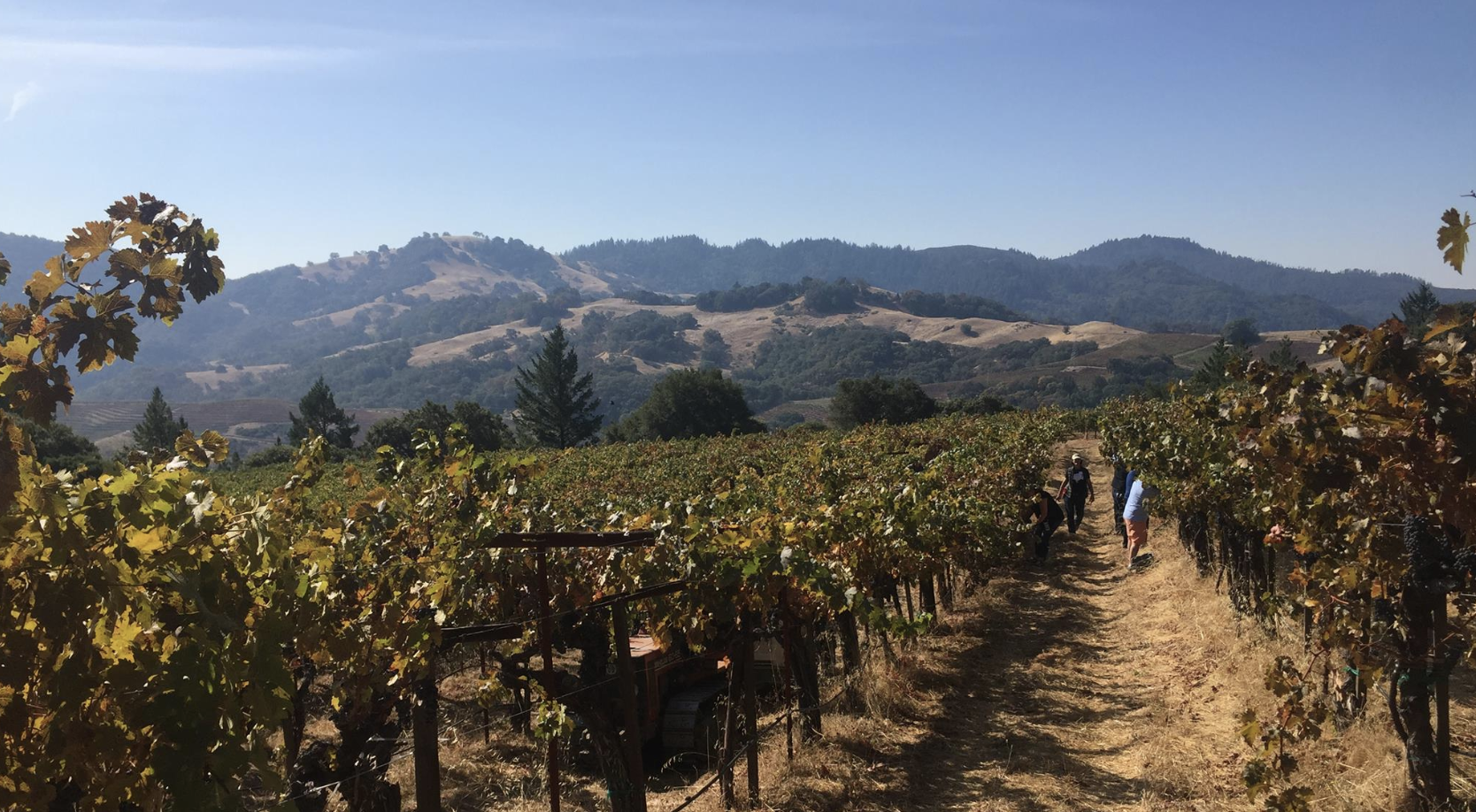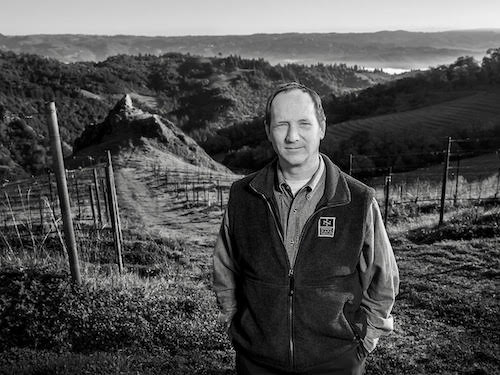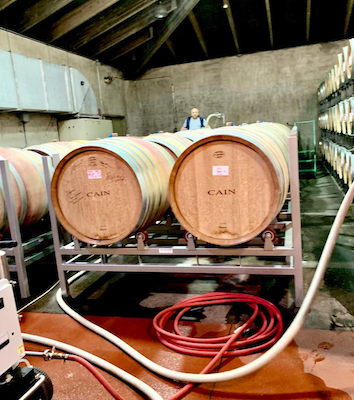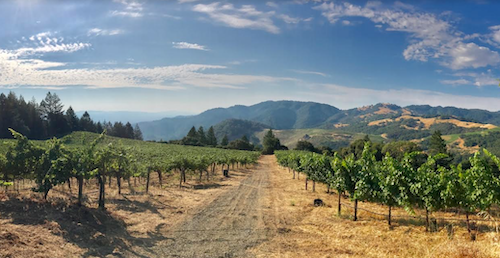
Cain Vineyard & Winery, a magnificent property perched on the crest of the Mayacamas range, high atop Napa's Spring Mountain District, has steeply terraced vineyards with heights of 1,400 to 2,100 feet. Standing amidst the rather isolated vines, breathing in cool mountain air, you truly get the sense of being in a different world, far from the valley floor below.
While the varieties planted at Cain may be typical of Napa — Cabernet Sauvignon, Cabernet Franc, Merlot, Malbec, and Petit Verdot — there the similarity ends. Cain wines are known for restraint and balance, along with a touch of rusticity, more comparable in style to leaner European wines than to their Napa neighbors' riper renditions.
 CEO and winemaker Chris Howell, a Seattle native who studied viticulture and enology in France, believes that the personality and character of wine begins with terroir, the physical features of the land: soil, elevation, steepness, exposure, and microclimate. Howell and his staff (many have been working with him 15+ years) seek a true reflection of the vineyard site and the vintage by staying out of the way as much as possible. "In the cellar, we monitor the basic chemistry of the must and the wine" says Howell, "but don't rely on 'correcting' it as a matter of course."
CEO and winemaker Chris Howell, a Seattle native who studied viticulture and enology in France, believes that the personality and character of wine begins with terroir, the physical features of the land: soil, elevation, steepness, exposure, and microclimate. Howell and his staff (many have been working with him 15+ years) seek a true reflection of the vineyard site and the vintage by staying out of the way as much as possible. "In the cellar, we monitor the basic chemistry of the must and the wine" says Howell, "but don't rely on 'correcting' it as a matter of course."
Cain produces three Cabernet blends, each drawn from unique vineyard sources: Cain Concept, made from grapes grown in the Rutherford and Atlas Peak appellations, Cain Cuvée, a blend of both mountain and valley floor fruit, and its flagship wine, Cain Five, made entirely from grapes grown high atop Spring Mountain.
Grape Collective caught up with the soft-spoken, philosophic Howell (once a student of philosophy at the University of Chicago) to talk about how everything starts with dirt. The following are excerpts from conversations with Howell over a dinner and two visits to the winery.
Lisa Denning: You talk about "wine beyond fruit." Can you tell us what you mean by that?
 Christopher Howell: I think the world of wine has gone through a lot of changes over the past few decades. We've all heard that word terroir now and we're making a little sense of it but we're still not sure what it means. We have folks coming out and saying it doesn't exist and we're still trying to explain it to ourselves.
Christopher Howell: I think the world of wine has gone through a lot of changes over the past few decades. We've all heard that word terroir now and we're making a little sense of it but we're still not sure what it means. We have folks coming out and saying it doesn't exist and we're still trying to explain it to ourselves.
(Photo: Christopher Howell, photo credit Bill Tucker.)
I would like people to think more about the core issue of the garden, the dirt, and how wine transcends the variety it's made from. In my generation we learned about grape varieties. People always ask, "How much cabernet is in it this year?" That's not the point. I believe that the more important questions are, "Where did it grow?' and "What does it taste like?" I think it's more important to think about grapes growing in a certain place.
I'm also interested in thinking about wine as fermentation, which is a transformation that takes us away from just grapes or just the variety. Fermentation is done in part by bacteria and yeast, and it conveys something more to the wine, and brings it beyond just fruit.
Should a wine only taste of grapes? For our wines, the story we're trying to get to people is that it isn't about the varietals, it's about the magic of the place. A wine should taste like where the grapes grew.
You talk about honest wine. What do you mean by that?
I think transparency is one of the core principles of what I mean by honest wines. Let me use Isabelle Legeron's Raw Wine Festival in NY as an example, and all those wonderful fairs now in France, Germany, Austria & Italy. What's behind all of them is a little bit rebellion and counterculture. But these people are simply saying that it's the wines that matter, that they come from the vineyard and they're not about the ingredients or the chemicals or the processing or all the other things that could be done to achieve a very high-scoring wine. Isabelle Legeron is all about being honest.
I highly encourage everyone to go to more than one of these fairs, taste more than one wine and be exposed to an entirely different world of wine. It's just like going to an organic farmers market and I think that this is an important part to the future of wine.
Then there are wines that have been basically made up to conform to an expectation so they can get a high score and be the wine that they think it should be. There's a lot of striving in the world of wine and I think sometimes we need to just relax. I hesitate to say this explicitly but a lot of Napa Valley works hard to make wines to get a good score from the important critical reviews and that style of wine is obviously not what we at Cain are trying to achieve.
Are you saying that honest wines embrace what happens naturally in the winemaking process, including what many consider flaws, like brettanomyces, a yeast that grows naturally on grapes?
I question some of the assumptions that we have in oenology where we have a litany of what we could call flaws. We've learned all the things you shouldn't do and I think you have to go through that and think that maybe some of those things, in certain contexts, can actually benefit a wine. With brettanomyces, there's an amazing spectrum of characteristics that it can bring to the wine, it's not just shit! It can add jasmine and rose aromas. The question is, does it add or does it take away? There's no doubt that brett can bring aromatic and tactile elements that some would identify as negative and many have been told "it's bad and you will learn to know it's bad." In one of my first jobs, I worked for a guy who swore he would never let it get into his cellar. What he didn't understand was that it was coming in from the grapes and yet he thought he could keep his cellar hermetically sealed. We're getting close to people wanting to sterilize the grapes and we don't want to work with sterile fruit. I compare it to cheese, which would you prefer, the pasteurized?
In one of my first jobs, I worked for a guy who swore he would never let it get into his cellar. What he didn't understand was that it was coming in from the grapes and yet he thought he could keep his cellar hermetically sealed. We're getting close to people wanting to sterilize the grapes and we don't want to work with sterile fruit. I compare it to cheese, which would you prefer, the pasteurized?
To those who are trying to get rid of flaws, I would say, be careful what you wish for. Keep in mind that what could be perceived as a flaw at a certain stage in the life of a wine may not be that 5 or 10 years later. Some of the wines that first seduced me were wines from Burgundy, Bordeaux, and the Rhône. They were not about brett but it was there. It's more about where the brett sits. If it's in front of the fruit, you have a tough time but if the brett sits in the right place, it can add complexity to the wine.
And how would you even get rid of brett if you were so inclined? Most of our friends probably know better than I, but a lot of wineries change the pH of the wine in the barrels and the wine becomes very acidic, so they have to adjust it again at bottling and make the pH very low so brett won't grow. Imagine all these chemicals.
We don't do a lot of changing in the vineyard and in the winery we are low intervention. We embrace what we have. We like to think about it as a belief in a different sense of beauty, and a belief in the place and honoring that. It's not about good or bad, we don't think that way either. We know that we're outside of the mainstream, but if all wines tasted the same, why bother?
Can you tell us about your flagship wine, the Cain Five, made from grapes grown in the vineyards of Spring Mountain?
The style of Cain Five is different than what you will find in much of the Napa Valley. It's not clear if we could have even made that ripe Napa style of wine had we wanted to. I don't think so. Our wines have their own distinct personality which we embrace as opposed to fighting it. We are interested in texture, finish, and balance. But we do have to admit that a large portion of American wine drinkers are looking for that big rich style and if someone is a Napa cab drinker, these mountain wines are going to be a very different experience. Cain Five began in 1985 and was inspired by the assemblage of Bordeaux. It's a blend of five varieties: Cabernet, Merlot, Cab Franc, Petit Verdot, and Malbec. I arrived at Cain in 1990, after spending a year in the Medoc, and not much has changed with our winemaking since that period of time. We have the same approach: no yeast, same elevage, no prohibitions on brett.
Cain Five began in 1985 and was inspired by the assemblage of Bordeaux. It's a blend of five varieties: Cabernet, Merlot, Cab Franc, Petit Verdot, and Malbec. I arrived at Cain in 1990, after spending a year in the Medoc, and not much has changed with our winemaking since that period of time. We have the same approach: no yeast, same elevage, no prohibitions on brett.
The blends are a little different each year, but the site is the key. Even though it's Spring Mountain, it's not all the same soils. Many of the vineyards on Spring Mountain have volcanic soil. Others have sandstone, clay and shale — which is what we have — and that creates a difference. There's so much variation in the soils in our own vineyards, from the top of the hill to the bottom of the hill. You can dig holes as you walk along each row and see how the soils change very quickly.
Our vineyards have many exposures and a lot of diversity of exposures, north, south, east, and west. Some vines are more vigorous than others and the grapes all mature at different times so we have several pass-throughs when we pick and we keep them all separate until blending in March or April.
We farm our vineyards organically but that's not really the point. What we have learned is the importance of living soil, and it is absolutely true, it's not a made up idea. If you want your vine roots to explore the garden, you need to have the soil to be as full of life as possible, without chemicals.
Another thing to consider is that It doesn't get as warm up here during the daytime as it does in the valley, but at night it can be a good deal warmer than in the valley. I believe, with no proof other than my simple belief, that the warm nights have a factor in the texture of the tannins. Living for a year in the Medoc, Bordeaux, where it stays rather warm during the night, and walking home after dark to Pauillac from St Julien, I could feel the vines living and breathing, doing something. Compare that to places that get really cold at night, and the vines shut down somewhat overnight.
I think our plants are still metabolizing during the night and the tannins are maturing in a different way, whereas the cold nights in other areas preserve the fruitiness of the wine. The maturity of the flavors and the tannins happens a little faster up here so, even though bud break starts a couple of weeks after it does in the valley, we're never that far behind when we're done harvesting.
You don't innoculate with purchased yeasts. Can you tell us more about that?
A lot has been said about yeast and we think of yeast as an ingredient or a mechanism. There are hundreds of strains of designer yeast that wineries can purchase. The reason we learned not to add yeast is because if you have intact fruit, it ferments differently. It's not about the yeast, and the berries are alive when they go into the tank so the reason we don't add yeast is to allow the fruit to do its thing before the yeast kicks in.
There's more going on in our vineyards and our cellars than we can understand. I think that we have to be open to that and not feel that technology will give us the answer. I'm not here to say what it is, but there's more than what we know. Since the early to mid-1990s, we have consistently found that wines fermented by indigenous yeast are more complex, with a broader, more complete palate feel. They are less fruity, less aromatically precise, but ultimately more satisfying.
Moreover, in the case of red wines, macerated wines, grapes soaking on their skins, there is much more to the initial fermentation than yeast. In those first few days in the vat, with the grapes soaking in their juice, much can be revealed. The grapes are still alive, they can do their own fermenting, even before the native yeasts have multiplied, if you let them. In the process, aromatics and flavors are metabolised and released from the skin of the berry into the wine. This may be the best reason to be patient and abstain from yeast inoculation.
When I first visited Napa, I was surprised at how much fruit is grown on the valley floor, instead of higher up on the hills and mountains, like in Europe. How did that come to be and what's your opinion of valley-grown wines?
The discussion of vines on the valley floor and New World vs Old World is not so simple as it might at first seem. Most city dwellers will not understand the determining effects of the interaction between climate (especially temperature, sunlight and rainfall) and soil (depth, slope, drainage) on where and how grapevines grow and produce fruit. The carpet of vines covering the floor of the Napa Valley absolutely needs to be seen in the context of climate - lots of rain in the winter, followed by essentially zero rain for six months creates an unusual and very specific situation. For the first 100 years of wine-growing in the Napa Valley, vineyards were simply not irrigated. This is only possible where the soil can hold enough water from the winter for the vines to grow.
The carpet of vines covering the floor of the Napa Valley absolutely needs to be seen in the context of climate - lots of rain in the winter, followed by essentially zero rain for six months creates an unusual and very specific situation. For the first 100 years of wine-growing in the Napa Valley, vineyards were simply not irrigated. This is only possible where the soil can hold enough water from the winter for the vines to grow.
In this context then, hillside vineyards, such as Cain, can be problematic. There is definitely better drainage on a hillside, and thinner soils with less water-holding capacity. Wine-growing becomes marginal, and only viable in certain locations. Irrigation, at least for late season maintenance, can be a necessity, especially for young vines.
During the Gold Rush, the people who came to Napa started growing grapes, and it was easier to do so on the valley floor, so the land up in the mountains was less desirable. My European friends, when they visit, they see these vines on the valley floor and, based on their references, they say, "You know what, I always knew that Napa was bullshit because all these vines are on the valley floor. This is a joke."
And so naturally, of course, I get a little defensive for my friends on the floor and I've come around to an explanation that works for me and I think it is completely honest. If it rained here in the summer, the valley floor would not work. But in Napa, unlike Europe, we have no rain at all during the summer and we have alluvial soils and these deeper soils can hold moisture. I am continually surprised when visitors from most of the rest of the US and the world are concerned about our summertime 'drought' when all the grass is brown as it always is, every year. It never rains in the summer, and we never expect rain.
So the next question is, why are they irrigating it? And I think that some of my friends on the valley floor say that since the soils are deep enough and you're on the valley floor, there's no need to irrigate, and then it's fine. But if you have an irrigated vineyard on the valley floor, then my European friends are right.
In the valley they can make good, tasty wines. The classical benchlands of the Napa Valley find a perfect balance between adequate water holding capacity and adequate drainage for these conditions.The reason that the Judgement of Paris favored California wines is because they're friendly and attractive wines. The wines of Europe, especially from those really difficult vintages, were not happy wines. You have to remember the judges were just people, they were somms and a few wine people, château owners like Bruno Prats from Bordeaux and Aubert de Villaine from Burgundy. They all responded to ripeness and because it was ripe, they liked it.










